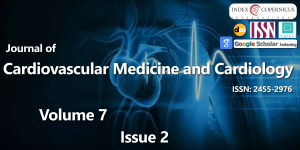Esophageal temperature evolution during high power short duration ablation: Numerical simulations and clinical suggestions
Main Article Content
Downloads
Article Details
Copyright (c) 2020 Fasano A, et al.

This work is licensed under a Creative Commons Attribution 4.0 International License.
Baher A, Kheirkhahan M, Rechenmacher SJ, Marashly Q, Kholmovski EG, et al. (2018) High-Power Radiofrequency Catheter Ablation of Atrial Fibrillation Using Late Gadolinium Enhancement MRI as a Novel Index of Esophageal Injury. JACC Clin Electrophysiol 4: 1583-1594. Link: https://bit.ly/2zy2u4g
Vassallo F, Cunha , Serpa E, Meigre LL, Carloni H, et al. (2019) Comparison of high power short duration (HPSD) ablation of atrial fibrillation using a contact force sensing catheter and conventional technique: Initial results. J Cardiovasc Electrophysiol 30: 1877-1883. Link: https://bit.ly/35XHrE5
Okamatsu H, Koyama J, Sakai Y, Negishi K, Hayashi K, et al. (2019) High-power application is associated with shorter procedure time and higher rate of first-pass pulmonary vein isolation in ablation index-guided atrial fibrillation ablation. J Cardiovasc Electrophysiol 30: 2751-2758. Link: https://bit.ly/2T4BbWa
Berte B, Hilfiker G, Moccetti F, Schefer T, Weberndörfer V, et al. (2019) Pulmonary vein isolation using ablation index vs. CLOSE protocol with a surround flow ablation catheter. J Cardiovasc Electrophysiol 30: 2199-2204. Link: https://bit.ly/2T18jOB
Bunch TJ, May HT, Bair TL, Crandall BG, Cutler MJ, et al. (2020) Long-term outcomes after low power, slower movement versus high power, faster movement irrigated-tip catheter ablation for atrial fibrillation. Heart Rhythm 17: 184-189. Link: https://bit.ly/2WtdrwN
Reddy VY, Grimaldi M, De Potter T, Vijgen JM, Bulava A, et al. (2019) Pulmonary Vein Isolation with Very High Power, Short Duration, Temperature-Controlled Lesions. The QDOT-FAST Trial. JACC: Clinical Electrophysiology 5: 778-786. Link: https://bit.ly/3cFsdWQ
Barbhaiya C R, Kogan EV, Jankelson L, Knottset RJ, et al. (2020) Esophageal Temperature Dynamics During High Power Short Duration Posterior Wall Ablation. Heart Rhythm 17: 721-727. Link: https://bit.ly/3bv9r3f
Berjano EJ, Hornero F (2004) Thermal-electrical modeling for epicardial atrial radiofrequency ablation. IEEE Trans Biomed Engineering 51: 1348-1357. Link: https://bit.ly/2xYqxJb
Berjano EJ (2006) Theoretical modeling for radiofrequency ablation: state of the art and challenges for the future. Biomed Eng Online 5: 24. Link: https://bit.ly/2T3Qz57
Pérez JJ, D'Avila A, Aryana A, Berjano E (2015) Electrical and Thermal Effects of Esophageal Temperature Probes on Radiofrequency Catheter Ablation of Atrial Fibrillation: Results from a Computational Modeling Study. J Cardiovasc Electrophysiol 26: 556-564. Link: https://bit.ly/2WtH4Os
Fasano A, Anfuso L, Bozzi S, Pandozi C (2016) Safety and necessity of thermal esophageal probes during radiofrequency ablation for the treatment of atrial fibrillation. J Atrial Fibrillation 9: 1434. Link: https://bit.ly/3bv9QTj
Fasano A, Anfuso L, Arena G, Pandozi C (2017) Cryo-ablation for pulmonary veins isolation: importance of ETM. J Atrial Fibrillation 9: 1-7.
Dhillon G, Ahsan S, Honarbakhsh S, Lim W, Baca M, et al. (2019) A multicentered evaluation of ablation at higher power guided by ablation index: Establishing ablation targets for pulmonary vein isolation. J Cardiovasc Electrophysiol 30: 357-365. Link: https://bit.ly/3dDHK9Z
Lemola K, Sneider M, Desjardins B, Case I, Han J, et al. (2004) Computed Tomographic Analysis of the Anatomy of the Left Atrium and the Esophagus Implications for Left Atrial Catheter Ablation. Circulation 110: 3655-3660. Link: https://bit.ly/3czLY2o
Tsao HM, Wu MH, Higa S, Lee KT, Tai CT, et al. (2005) Anatomic Relationship of the Esophagus and Left Atrium. Chest 28: 2581-2587. Link: https://bit.ly/3fNb7IA
Anfuso L, Corsi M, Fasano A (2018) Esophageal thermal probes: how fast should they be? M J Cardiol 3: 018. Link: https://bit.ly/2T1Qq1S
Black-Maier E, Pokorney SD, Barnett AS, Zeitler EP1, Sun AY, et al. (2017) Risk of atrioesophageal fistula formation with contact force–sensing catheters. Heart Rhythm 14: 1328-1333. Link: https://bit.ly/3buNhxU





